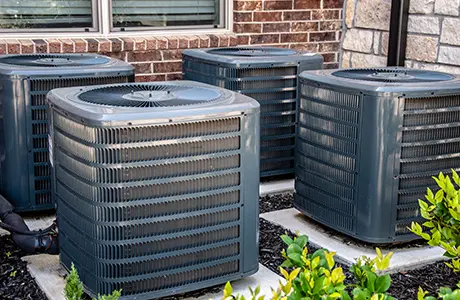Professional indoor air pollution services create a cleaner, healthier living environment. The service professionals at your local Aire Serv have the tools and knowledge to identify invisible pollutants, improve ventilation, and address specific issues like mold, germs, allergens, or volatile organic compounds (VOCs). With our help, you can enjoy better air quality, reduced health risks, and greater peace of mind.
Explore the benefits of expert testing, detailed cleaning and filtration, and long-term prevention strategies to see how these services make a lasting impact on your home or commercial space.
Why Choose Aire Serv for Indoor Air Pollution Solutions?
When it comes to improving your home or business's air quality, Aire Serv is the trusted name for expert solutions. With years of hands-on experience and local teams with skilled HVAC experts, we understand how to identify and address even the most stubborn indoor air pollution issues. From installing advanced filtration systems to improving ventilation and controlling allergens, we provide tailored solutions that prioritize your health, safety and comfort.
What sets us apart? Our dedication to quality and customer satisfaction, backed by the Neighborly Done Right Promise™. We ensure the job is done right, giving you peace of mind. Plus, our transparent pricing and commitment to exceptional customer service make us a trusted choice for delivering long-term results. Learn more about our expertise in providing advanced indoor air quality solutions for homes and businesses.
Advantages of Reducing Indoor Air Pollutants with Aire Serv
Reducing air pollutants requires taking proactive steps that deliver a cleaner, healthier indoor environment. Our process starts with a detailed assessment of your home or business's air quality, using professional-grade tools to identify specific issues such as allergens, mold, dust, germs, and VOCs. This allows us to create a customized plan tailored to your unique needs, focusing on both immediate improvements and long-term results.
Our local teams use advanced techniques and equipment to address air quality problems at their source. Whether it’s installing high-efficiency air filtration systems, optimizing ventilation to reduce stale air, or managing humidity levels to prevent mold growth, we ensure every solution is designed to make your air cleaner and healthier. Beyond fixing current issues, we provide insights and recommendations to help maintain cleaner air so you can breathe easier every day.
At Aire Serv, we believe in combining expertise, advanced technologies, and a customer-focused approach to deliver results you can trust.
Tips for Minimizing Indoor Air Pollution in Your Home or Business
Keeping a home or business’s air clean and healthy is easier when you know what to look for. Start by identifying hidden sources of indoor air pollution, like carpets that trap dust, poorly ventilated bathrooms, or even cleaning products that release VOCs. Consider upgrading to high-quality HVAC air filters and make a habit of changing them regularly—this simple step can make a big difference in capturing airborne particles like dust and pollen.
Another pro tip? Pay attention to humidity levels. High humidity encourages mold growth, while low humidity can make dust and allergens circulate more easily. A dehumidifier or humidifier, depending on your climate, can help maintain that ideal balance. If you use candles or a fireplace, opt for clean-burning options and ensure proper ventilation to reduce soot and other pollutants.
All Aire Serv franchises are locally owned and operated and may offer fewer or more services than those listed here. To learn more about the indoor air pollution services offered in your area, contact the Aire Serv nearest you for details or a customized on-site assessment.
 Click to call
Click to call



